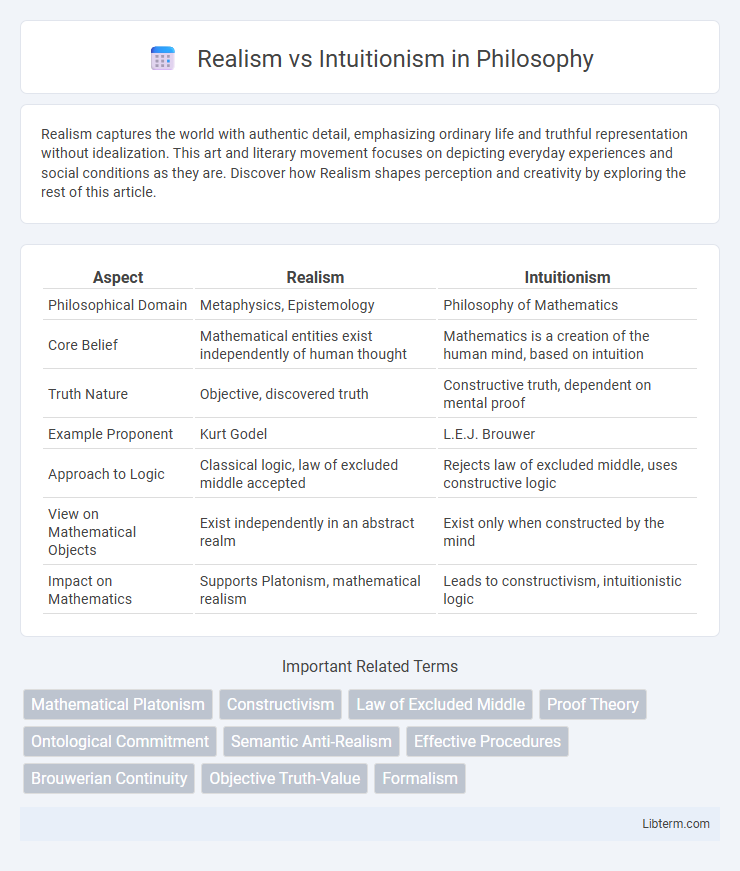Realism captures the world with authentic detail, emphasizing ordinary life and truthful representation without idealization. This art and literary movement focuses on depicting everyday experiences and social conditions as they are. Discover how Realism shapes perception and creativity by exploring the rest of this article.
Table of Comparison
| Aspect | Realism | Intuitionism |
|---|---|---|
| Philosophical Domain | Metaphysics, Epistemology | Philosophy of Mathematics |
| Core Belief | Mathematical entities exist independently of human thought | Mathematics is a creation of the human mind, based on intuition |
| Truth Nature | Objective, discovered truth | Constructive truth, dependent on mental proof |
| Example Proponent | Kurt Godel | L.E.J. Brouwer |
| Approach to Logic | Classical logic, law of excluded middle accepted | Rejects law of excluded middle, uses constructive logic |
| View on Mathematical Objects | Exist independently in an abstract realm | Exist only when constructed by the mind |
| Impact on Mathematics | Supports Platonism, mathematical realism | Leads to constructivism, intuitionistic logic |
Introduction to Realism and Intuitionism
Realism in philosophy asserts that mathematical entities exist independently of human minds, emphasizing objective truth and discoverable realities. Intuitionism challenges this by arguing that mathematical knowledge is a product of mental constructions, where truth depends on provability within the mind's intuitive processes. The debate between Realism and Intuitionism centers on whether mathematics is discovered or invented, shaping foundational perspectives in epistemology and logic.
Historical Background of Realism and Intuitionism
Realism in philosophy emerged prominently in the 19th century, rooted in the belief that mathematical entities exist independently of human thought, influenced by figures like Gottlob Frege and David Hilbert. Intuitionism developed in the early 20th century, led by L.E.J. Brouwer, who argued that mathematics is a mental construction grounded in the intuition of time and rejected the law of excluded middle. The historical divergence between Realism and Intuitionism reflects the broader philosophical debate on the nature of mathematical truth and existence.
Key Philosophical Differences
Realism asserts that mathematical objects exist independently of human thought, emphasizing an objective reality discoverable through logic and reason. Intuitionism, by contrast, contends that mathematical truths are mental constructions, dependent on human intuition and constructive proof rather than an external reality. The key philosophical difference centers on the existence and knowability of mathematical entities--Realism supports a Platonist ontology, while Intuitionism focuses on known, verifiable constructs within the human mind.
Realism: Core Principles and Proponents
Realism in philosophy of mathematics asserts that mathematical entities exist independently of human minds and language, embodying objective truths discovered rather than invented. Key proponents such as Kurt Godel and Roger Penrose argue that mathematical objects have an ontological reality that transcends subjective perception, grounding mathematical knowledge in an external, immutable realm. This stance contrasts with Intuitionism by emphasizing the discoverability of mathematical truths rather than their construction within mental frameworks.
Intuitionism: Foundations and Main Thinkers
Intuitionism in mathematics posits that mathematical truths are known through mental constructions rather than existing independently in an external reality, emphasizing the constructive processes over abstract entities. Founded by L.E.J. Brouwer, this philosophy rejects classical logic's law of excluded middle, advocating that mathematical objects are created by the mathematician's intuition. Key thinkers like Arend Heyting and Hermann Weyl further developed Intuitionism's formal framework and its implications for constructive mathematics and proof theory.
Debate Over Mathematical Truth
The debate over mathematical truth between Realism and Intuitionism centers on whether mathematical objects and truths exist independently of human thought or are constructed by the mind. Realists argue that mathematical truths are objective and discovered, reflecting an external mathematical reality, whereas Intuitionists maintain that truth is tied to provability within a constructive mental framework. This fundamental disagreement influences approaches to concepts such as infinity, proof validity, and the law of excluded middle in formal mathematics.
Implications for Logic and Proof
Realism in logic asserts that mathematical truths exist independently of human knowledge, implying that classical logic and the law of excluded middle hold universally. Intuitionism, by contrast, denies the universal law of excluded middle, emphasizing constructive proofs where a statement's truth requires explicit demonstration, leading to intuitionistic logic frameworks. This divergence fundamentally impacts proof theory, as intuitionism restricts acceptable proofs to those that can be explicitly constructed, rejecting non-constructive existence proofs accepted in classical realism.
Criticisms of Realism and Intuitionism
Criticisms of Realism highlight its reliance on an objective reality independent of human cognition, which some argue ignores the constructive role of mental frameworks in knowledge formation. Intuitionism faces challenges for its subjective basis in moral knowledge, as critics claim it lacks empirical verifiability and struggles with intersubjective agreement on intuitive judgments. Both positions confront critiques regarding their epistemological foundations and the extent to which moral or factual truths can be truly apprehended or proven.
Contemporary Perspectives and Applications
Contemporary perspectives on Realism vs Intuitionism emphasize their divergent approaches to mathematical truth, with Realism asserting the existence of objective mathematical entities independent of human thought, while Intuitionism views mathematics as a mental construct grounded in constructive proofs. In applied areas such as computer science and logic, Intuitionism influences the development of constructive algorithms and proof theory, ensuring verifiable and computable outcomes. Realism continues to underpin classical mathematical frameworks in physics and engineering, supporting theoretical models that assume an external mathematical reality.
Conclusion: Comparing Strengths and Limitations
Realism offers robust ontological commitments and aligns with classical logic, providing clear truth values to mathematical statements, which facilitate objective proof and verification. Intuitionism emphasizes constructivist principles, highlighting the importance of mental constructions and algorithmic verifiability, but it restricts classical reasoning and often leads to weaker formulations of mathematical results. The choice between Realism and Intuitionism depends on the priority given to objective truth versus constructive proof, balancing philosophical clarity with practical applicability in mathematics.
Realism Infographic

 libterm.com
libterm.com